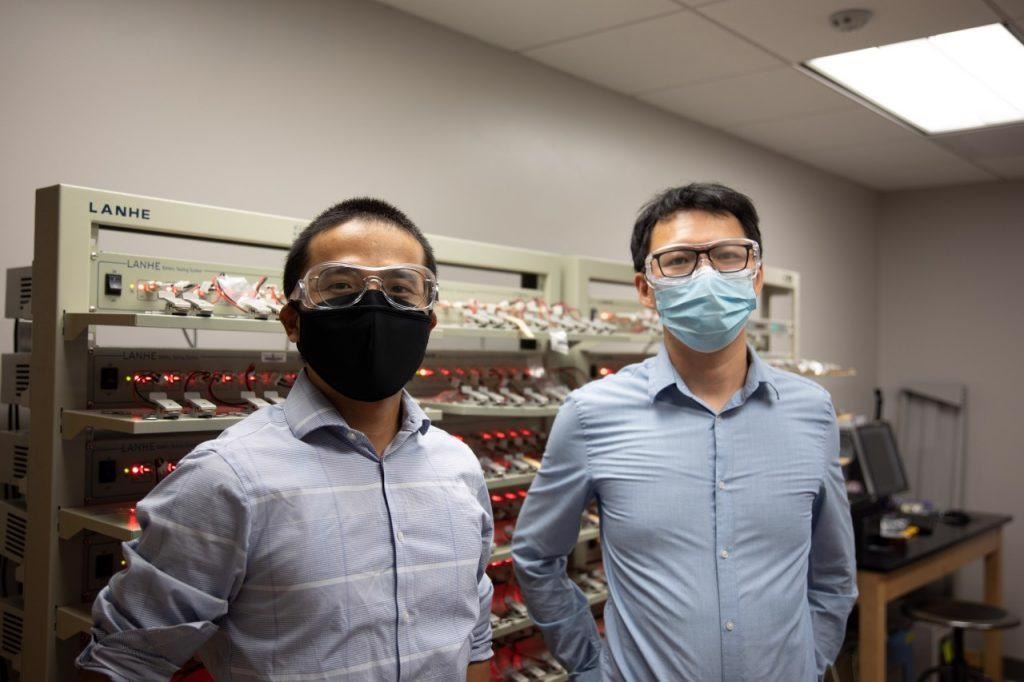The one thing that spent grain, apple cores and walnut shells have in common, is that they could someday be utilized to power a data center.
 Feng Lin and Haibo Huang discovered a potential method to convert food waste into batteries. Image Credit: Max Esterhuizen for Virginia Tech.
Feng Lin and Haibo Huang discovered a potential method to convert food waste into batteries. Image Credit: Max Esterhuizen for Virginia Tech.
The world that people currently live in is working towards developing eco-friendly and economic ways to power these devices. Therefore, two researchers from Virginia Tech analyze how food waste and its related biomass can be converted into rechargeable batteries.
This research could be a piece of the puzzle in solving the sustainable energy problems for rechargeable batteries. Demand for these reusable batteries has skyrocketed and we need to find a way to reduce the environmental impacts of batteries.
Haibo Huang, Project Co-Lead and Associate Professor, Department of Food Science and Technology, College of Agriculture and Life Sciences, Virginia Tech
The study has been financially supported through a three-year $450,000 grant from the United States Department of Agriculture Foundational and Applied Science Program with the priority area of bioengineering and bioprocessing. The grant runs through until April 2023.
From the preliminary findings, the researchers discovered that the fiber component present in food waste was the major one to develop advanced carbon materials that could be utilized as a battery anode. It is known as the negative terminal of a battery.
Our unique approach of using agricultural waste-derived carbon materials to host alkali metal, such as lithium and sodium, will bring major advances to agricultural waste processing and battery technology.
Feng Lin, Project Principal Investigator and Associate Professor, Department of Chemistry, Virginia Tech
This study will advance the utilization of agricultural waste produced in agricultural systems for value-added carbon production and eventually energy storage devices.
The researchers make use of abundant, highly tunable and affordable raw materials to fulfill the requirement in the field of energy storage. Making use of the waste-derived carbon materials as the host for metal anodes could considerably decrease alkali metal usage for every battery.
Powering Up
Recently, Huang and Lin played a game of pickup basketball when this concept struck them.
We thought why not convert food waste into battery materials because of how much food waste there is across the globe. Most of these wastes are put into garbage and then sent to landfills. We just need to solve the battery side.
Haibo Huang, Project Co-Lead and Associate Professor, Department of Food Science and Technology, College of Agriculture and Life Sciences, Virginia Tech
Graphite, which is a limited resource, is heavily relied upon to develop battery anodes. Initially, various types of food waste material were tested by scientists to observe if any of them could be utilized to make batteries.
Huang stated, “As a food processing engineer, I can modify the composition of the food. I could take the proteins and lipids out, along with some of the minerals, to see how it impacts battery performance.”
The researchers discovered that the removal of a few compounds from the equation led to the key compounds of lignin, hemicelluloses and cellulose left out after thermal treatment could adequately work for a battery.
An Apple a Day Keeps the Charger Away
In the forthcoming final two years of the project, the researchers will additionally test the food-waste-turned-carbon, with feedback obtained from the laboratory to improve the battery science. The last step will be an economic analysis on the possibility of implementing this technology to guarantee its usage when pushed to the market.
The technology’s expected initial uses are low-priced energy storage solutions for data centers or other huge energy storage facilities where the battery size is not considered. As they advance, the researchers believe they can convert food waste into carbon that lacks the impurities experienced currently.
Huang stated, “We have the opportunity to solve two urgent issues in two different industries. A lot of energy is already put into the production and transportation of food in the food supply chain. We must recover the value from food waste. This is the perfect opportunity, as battery production looks for different materials than the traditional carbon.”
While the technology might not resolve the issue of having to replace batteries in the TV remote just yet, the researchers are helping us get closer to having food waste power the devices that are utilized by people every day.
The power of spent grain, apple waste and walnut shells should not be underestimated.